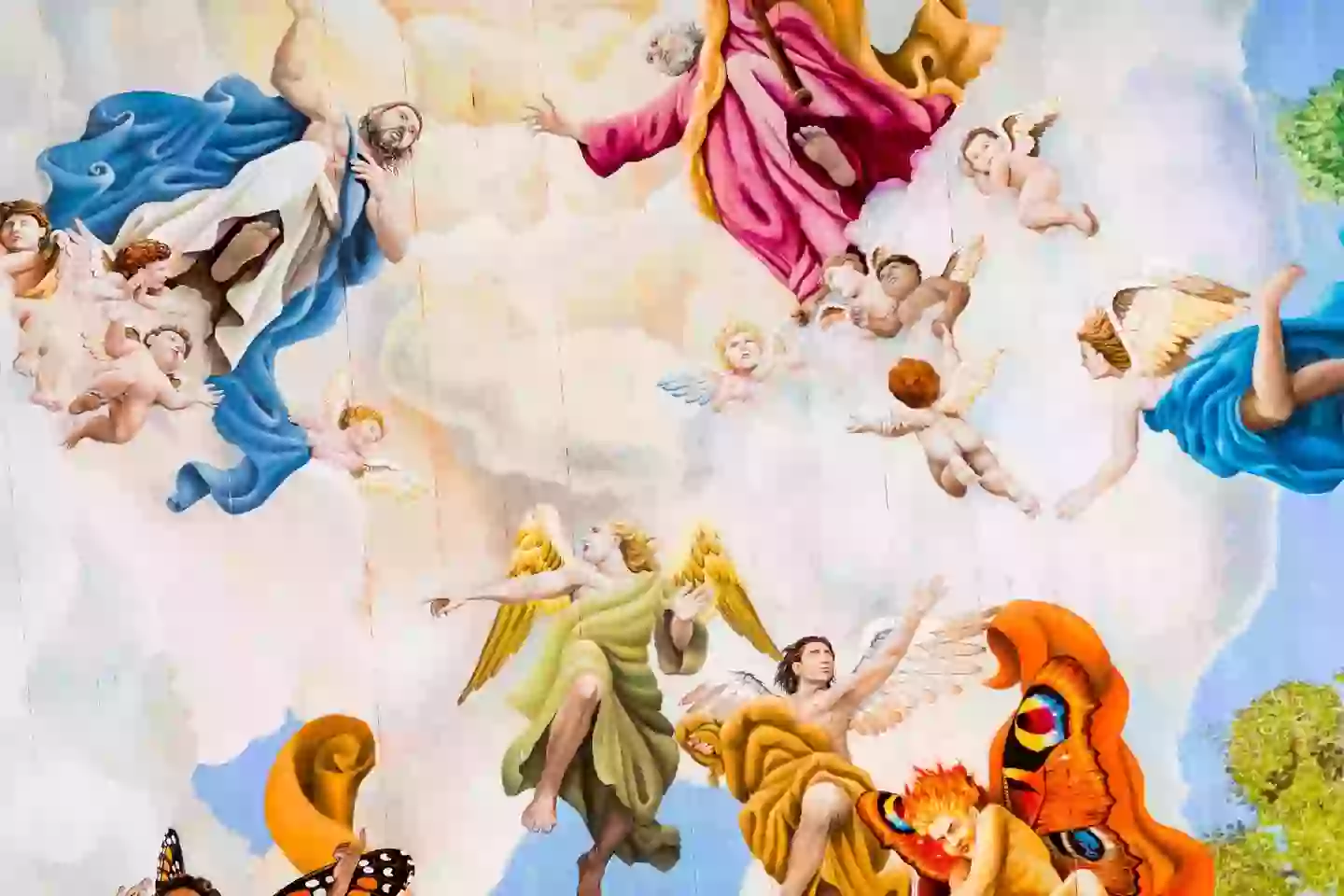
Man Shares His 'Proof' of Life After Death and the Seven 'Stages' of the Afterlife
Many people are intrigued by the concept of the afterlife, but unless we experience it ourselves, it remains an enigma. Chris Carter, an author who delves into the mysteries of life after death, has become captivated by the idea of transcending Earth after passing away. His focus has been on the work of Frederic Myers, a British poet and founder of the Society for Psychical Research, who claimed to have glimpsed life beyond death.

In his book The Case for the Afterlife, Carter explores the post-death communications of Myers, who passed away at the age of 57 in 1901. According to Carter, 23 years after Myers' death, psychics received messages from him that provided insights into the afterlife. These messages form the foundation of Carter's investigation.
Carter recounts that Myers described a "stupendous journey" of the soul through various planes or spheres of existence, beginning with Earth. According to Myers, there are six planes beyond Earth that a soul will travel through after death. Carter believes these descriptions offer 'proof' of the afterlife, though he suggests that it might not be exactly what we imagine.
Level One: Earth - The Starting Point
The journey begins on Earth, which is considered the first level. Earth serves as a kind of starting point for souls as they transition to higher planes. This phase is where souls are still deeply connected to the material world and undergo their initial transition.
Level Two: Hades - The Intermediate State
After Earth, Myers described the second plane as Hades, which corresponds to the astral plane. This is considered a temporary resting place that sits on the boundary between the physical world and the spiritual realms. According to Carter, the time spent in Hades depends on individual needs. Myers himself described Hades as a place of rest, particularly for those who pass away feeling weary. He referred to it as "a place of half-lights and drowsy peace," where souls could recharge before continuing their journey.

Level Three: The Sphere of Terrene Imagination
The third plane, Myers explained, is similar to Earth, but with a beauty far beyond what we experience in the material world. Souls on this plane are said to form communities based on mutual interests, living in environments designed to fit their personal preferences. However, the conditions on this plane depend on the individual's moral and spiritual development during their earthly life. Those who led selfish or immoral lives are believed to experience darker, desolate parts of this plane, where they remain until they are ready to move on.
Level Four: Eido - The First Heaven World
The fourth plane, known as Eido, is described as a "true heaven-world," where colors and sights are far more vivid and beautiful than anything conceivable on Earth. This is where Myers himself reportedly ended up, describing it as a serene and awe-inspiring realm.
Level Five: The Plane of Flame
The fifth plane, called the Plane of Flame, is harder to describe. It lies further from our earthly experience, but it is still considered desirable. Myers mentioned that the higher planes grow more distant from our understanding, yet they hold an increasing level of purity and spiritual advancement.

Level Six: The Plane of Light
In the sixth plane, souls shed their physical bodies entirely and exist as "pure thought," described as white light. In this realm, souls have joined the immortals and are now part of a higher, spiritual existence. This plane represents a significant step towards enlightenment and connection with the divine.
Level Seven: Out-Yonder - Flight from the Physical Universe
The seventh and final plane, referred to as "Out-Yonder," is the furthest stage in the afterlife. Contrary to common religious teachings, Carter suggests that there is no Hell or Heaven in the traditional sense at this level. Instead, Hell is described as a "fire of the mind" rather than a place of torment. Souls do not immediately meet God after death, as they are too primitive to directly approach the divine. In this realm, souls are gradually elevated until they reach a point where they can begin to connect with God.
Carter's interpretation of Myers' post-death communications highlights that the journey of the soul is a process of spiritual development, beginning with Earth and moving through various planes until it reaches a state of divine proximity. According to Myers, the afterlife is not simply a place of eternal rest but an ongoing journey of growth and enlightenment, with each plane offering unique opportunities for transformation and healing.
The final plane, as described by Myers, provides a direct path to connect with God, but it is only accessible after the soul has evolved through the previous stages. This perspective offers a fascinating and complex view of the afterlife, one that is far different from traditional notions of Heaven and Hell.
News in the same category


World-first sperm race is happening soon and the creators have revealed how it will work

Scientists Grow First Fully Formed Tooth In Lab — A Groundbreaking Breakthrough

New COVID Wave Surges — Health Officials Sound Alarm As Cases Double

10 Things That Men May Find Unattractive About Women Over 50

8 Signs You Might Be Affected by Lactose Intolerance

Understanding Diabetes: Types, Symptoms, Risks, and How to Manage It

Doctors Highlight A Rare Cancer Symptom That Can Appear On Your Toenails

Stroke Warning Signs: When Your Body Sends a Silent SOS

Understanding Cholesterol: The Good, the Bad, and How to Keep It in Check

Only 1 Cup a Day: Choose 1 of These 3 Drinks to CLEANSE Your Fatty Liver!

SHOCKING Tips to Lower Cholesterol! Foods You Need to Know!

7 Kinds of Pain That Shouldn't Be Ignored

Natural Nighttime Elixir: Reduce Belly Fat in Four Days Safely

10 Reasons You’re Drooling While You Sleep and What It Could Mean

Scientists Successfully Grow Human Teeth in Lab — A Breakthrough in Dental Regeneration

The 4 Dangerous Qualities of “Dark Empaths”

7 SHOCKING Benefits of Cayenne Pepper You Never Knew!

What Is Brain Fog? Scientists Are Finally Starting to Find Out

70-Year-Old Woman Who Used Her Deceased Son's Sperm to Have His Child Through Surrogacy Shares Update After Birth
News Post

URGENT: These Foods Improve Circulation INSTANTLY!

THEY BEGGED ME TO QUIT MY JOB TO WATCH MY GRANDKIDS – NOW THEY'RE DUMPING ME FOR DAYCARE

Grandma Saw the Sweater She Knitted for Her Granddaughter Donated and Decided It Was Time for a Talk About Appreciation

My Late Mom Left Me a Trust Fund, but My Dad Took Money from It for His Stepdaughter — I Finally Retaliated

My Husband Made Me Sell My Apartment to Pay Off His 'Business Debts' After Being 'Dumped' by His Partner — But It All Turned Out to Be a Lie

My Landlord Raised My Rent Because I Got a Promotion — Big Mistake Messing With a Single Working Mom of Three

All the Guests Brought Black Gifts to My Birthday Party — If Only I Knew What Was Coming

Cleaner Stepped Into a Stranger’s Home

My Mom Avoided Me for Years

My Best Friend Asked Me to Watch Her Kids for an Hour – I Didn't See Her Again for 7 Years

My Husband Had Been Secretly Transferring Money from Our Joint Account to My Best Friend for Months

Doctors make disturbing discovery in the brains of heavy alcohol drinkers that 'can cause long-term effects'

World-first sperm race is happening soon and the creators have revealed how it will work

Scientists Grow First Fully Formed Tooth In Lab — A Groundbreaking Breakthrough

New COVID Wave Surges — Health Officials Sound Alarm As Cases Double

10 Things That Men May Find Unattractive About Women Over 50

8 Signs You Might Be Affected by Lactose Intolerance

Understanding Diabetes: Types, Symptoms, Risks, and How to Manage It

Doctors Highlight A Rare Cancer Symptom That Can Appear On Your Toenails
